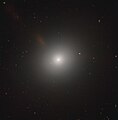Faili:Messier105 - HST - Potw1901a.jpg

Ukubwa wa hakikisho: piseli 591 × 599. Ukubwa zingine: piseli 237 × 240 | piseli 473 × 480 | piseli 758 × 768 | piseli 1,010 × 1,024 | piseli 2,020 × 2,048 | piseli 7,572 × 7,676.
Faili halisi (piseli 7,572 × 7,676, saizi ya faili: 15.83 MB, aina ya MIME: image/jpeg)
Historia ya faili
Bonyeza tarehe/saa kuona faili kama ilivyoonekana wakati huo.
| Tarehe/Saa | Picha ndogo | Vipimo | Mtumiaji | Maelezo | |
|---|---|---|---|---|---|
| sasa hivi | 05:23, 7 Januari 2019 |  | 7,572 × 7,676 (15.83 MB) | Fabian RRRR | == {{int:filedesc}} == {{Information |description={{en|1=''' The heart of the Lion The heart of the Lion It might appear featureless and unexciting at first glance, but NASA/ESA Hubble Space Telescope observations of this elliptical galaxy — known as Messier 105 — show that the stars near the galaxy’s centre are moving very rapidly. Astronomers have concluded that these stars are zooming around a supermassive black hole with an estimated mass of 200 million Suns! This black hole releases hug... |
Matumizi ya faili
Hakuna kurasa zozote zinazotumia faili hii.
Matumizi ya faili ulimwenguni
Wiki nyingine hutumia faili hizi:
- Matumizi kwa ar.wikipedia.org
- Matumizi kwa az.wikipedia.org
- Matumizi kwa be-tarask.wikipedia.org
- Matumizi kwa bn.wikipedia.org
- Matumizi kwa ca.wikipedia.org
- Matumizi kwa ce.wikipedia.org
- Matumizi kwa ckb.wikipedia.org
- Matumizi kwa cs.wikipedia.org
- Matumizi kwa de.wikipedia.org
- Matumizi kwa diq.wikipedia.org
- Matumizi kwa en.wikipedia.org
- Matumizi kwa es.wikipedia.org
- Matumizi kwa et.wikipedia.org
- Matumizi kwa eu.wikipedia.org
- Matumizi kwa fr.wikipedia.org
- Matumizi kwa hu.wikipedia.org
- Matumizi kwa id.wikipedia.org
- Matumizi kwa it.wikipedia.org
- Matumizi kwa mg.wikipedia.org
- Matumizi kwa mk.wikipedia.org
- Matumizi kwa no.wikipedia.org
- Matumizi kwa simple.wikipedia.org
- Matumizi kwa tt.wikipedia.org
- Matumizi kwa vi.wikipedia.org
- Matumizi kwa www.wikidata.org
- Matumizi kwa zh-yue.wikipedia.org


